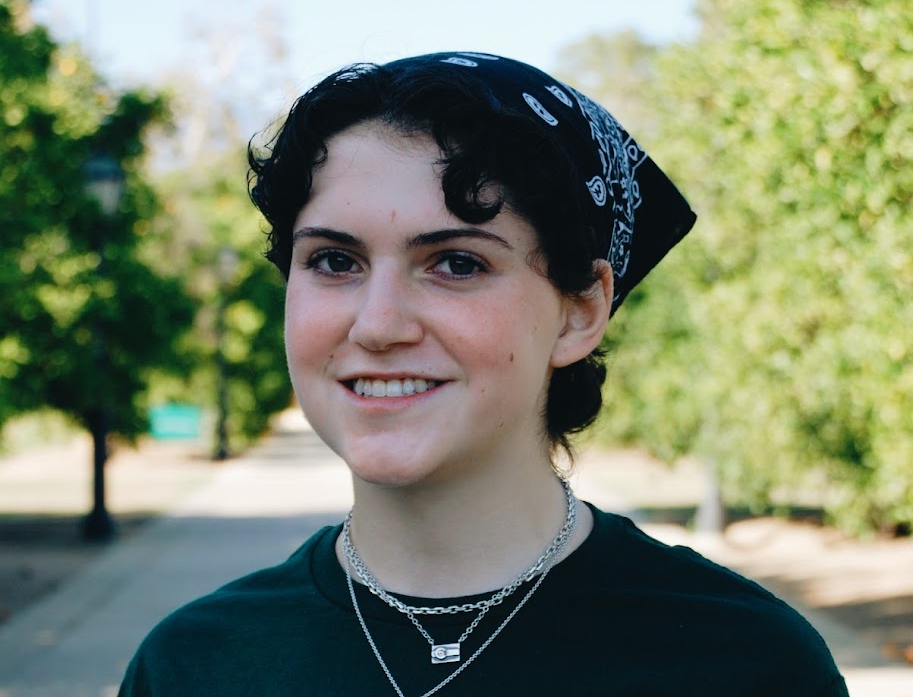By Emily Glory Peters

Scripps Scrapps, a sustainability-centered program, with Cecelia Blum ’24 (front center) and Sustainability Coordinator Lauren Ng (far right)
Sustainable practices at Scripps, says Cecelia Blum ’24, aren’t always visible to the naked eye. Even so, she asserts that involving students in initiatives is critical in helping the College on its sustainability journey.
“I’ve only recently realized how little I see of what goes on behind the scenes on campus: changes that aren’t glamorous, but make a bigger difference,” says Blum, who belongs to both the Student Sustainability Committee and the College’s main Sustainability Committee. “But there is also stuff that students are more likely to see—like leaky sprinklers, lawns being waterered the day after it’s rained—that needs to be addressed.”
Originally envisioned as a presidential advisory council back in 2008, today the College’s core Sustainability Committee unites Scripps staff, faculty, and students to promote green initiatives across campus.
Attracted to sustainability efforts since high school, Blum says she joined to boost transparency between College administration and students on environmentally friendly practices. Much of this work is powered by Scripps’ donors, whose gifts to sustainability have helped pave the way for both admin- and student-led projects.
With Support from Donors, Students Step Up to the Sustainability Plate

Cecelia Blum ’24 joined both the student and the campus-wide sustainability committees last year
Last year, Blum was instrumental in working with the Office of Sustainability to revive the Scripps Scrapps program, which allows returning students to shop from items that outgoing graduates leave behind. This year, she’s expanding into new areas.
“I’m involved in the Scripps Free Closet, which will take used clothing and make it available for students. I’m also researching what we can do on a student and institutional level to be more water-conscious and capture rainwater as the drought and flood periods become worse here in Southern California,” Blum explains.
Although a typical peer might not know about all of the sustainability projects underway on campus, Blum represents a growing student force effecting positive environmental change at Scripps.
In 2011, students and staff founded Scripps’ Green Bikes program to offer bike rentals and repairs; in 2012, a prior student-designed proposal brought Scripps’ inaugural Olive Harvest to life; in 2014, students successfully advocated for new housing in Schow Hall to meet LEED Gold standards; in 2018, Scripps Associated Students worked with staff to introduce the Scripps Scrapps program; and in 2021, student advocacy helped the College contract with a new, more sustainable dining partner.
Not to be outdone, the current Student Sustainability Committee is developing a partnership with Generation Conscious to supply Scripps’ housing with zero-waste laundry detergent. Blum’s hope is that other students will take note and become curious about how they can get involved.
“Sustainability plays into many social justice causes,” she says. “If I could share anything with my peers, it would be to encourage them to look at where sustainability can coincide with their other interests.”
Setting Up Scripps and Students for Long-term Environmental Impact
Thanks in part to Scripps’ donors, the College has recently increased the number of sustainability-related internships and on-campus jobs. In turn, more students like Blum have developed career competencies they can apply in their post-Scripps lives.
“When you give to sustainability at Scripps, you’re supporting so many rich endeavors for students to share their contributions and leave a lasting legacy,” says Scripps Director of Facilities Operations and Sustainability Lesley Swick. “There’s a lot of volunteer work, but we want full transparency and to set a tone of paying students for their work—an expectation that should continue into their post-college professional lives. Donors help fund that expansion.”
For Blum, this support also means creating more ways for the institution and its community to collaborate on green efforts. After all, if students, staff, faculty, and donors can help Scripps become more sustainable, what could the community achieve on a societal level?
“It can be easy to forget about the actual world in an idyllic place like Scripps—but sustainability is caring about how your actions impact others, being a good steward of the environment for others,” Blum says. “Investing in sustainable behavior while we’re here models that we care not just about this beautiful campus on its own, but the larger world as well.”
Help fuel a greener future at Scripps and beyond—make a gift to the Innovation and Sustainability Fund here.

